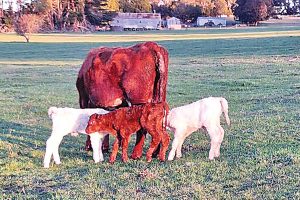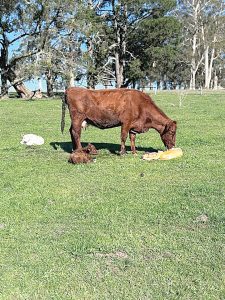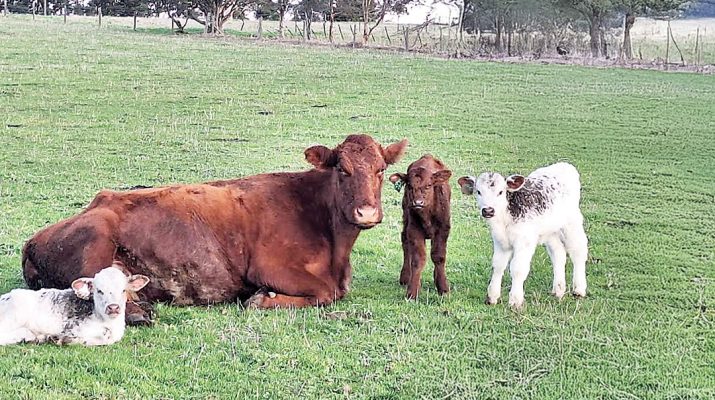Katrina BRANDON
AN UTTER surprise has come knocking at the doors of farmer Doug Benson – one of his cows gave birth to triplet calves.

“I think it’s fairly incredible,” Mr Benson told Gippsland Farmer.
“I’ve not seen it before, and I have been doing this for years! We’ve only had a couple of sets of twins before now.”
Since 1951, Mr Benson’s family has lived on their farm in Buln Buln, north of Warragul, where they initially owned a 6.5-hectare property, but bought additional land in 2016.
Now farming on 77.5 hectares, plus an additional 25 hectares of leased land, Mr Benson has 115 breeding cows.
Since 1977, Mr Benson’s family has bred shorthorn cattle due to their temperament, fertility and ease of management.
Before buying the property, Mr Benson spent 12 years working in FIFO (fly-in, fly-out) operations in northern Australia.
“I worked for FIFO from 2005 to 2017 in North Queensland, Central Queensland, Northern Territory and Western Australia. When I came home, my son had looked after the farm,” he said.
“When I got the opportunity to buy the farm, I took it. Since we have had the farm, we have a couple of grandkids, and one of them is right into the farm.
“He loves bucket-rearing calves.”
According to Mr Benson, so far, the mum and three calves have been exceptional.
The cow that gave birth to the triplets is six-years-old with no prior history of giving birth to triplets. The calves weighed in at 30 kilograms each, with one red and two white, and were born naturally over three hours.
“I went and checked that she calved, and she had a white one sitting in front of her, and I thought, ‘Oh yeah, she’s carved’.”

Photo: Contributed
“She was a fair way from me, and there were other cows, which I wanted to check. Went around and had a look at them, and by the time I looked at them and came back, I thought, because she was standing up and she had her backside towards me, I thought, ‘I reckon you’re calving again’,” Mr Benson said
Needing to go to work, Mr Benson called in his daughter-in-law for help and mentioned that the cow was having twins, only to find out later that it was triplets.
When a third lot of feet appeared, Mr Benson’s daughter-in-law sent through the text confirming the incredible news.
“She goes, ‘She’s got a red calf on the ground. I reckon I can see feet.’ I said, ‘There won’t be feet’. About 20 minutes later, she texted and said, ‘Yep, she had another white one coming up backwards.’
“It’s sort of blowing me away. Look, we’ve got one other set of twins this year, but we don’t normally get twins or anything.”
Not only did the cow birth all three naturally and on her own, but Mr Benson said she had bounced back better than most cows. Having three calves, he said that she has kept a firm eye on them at all times, even getting upset when other cows try to steal her calves.
“She’s a good mother, she’s feeding them herself. She’s going crooked at the moment because I’ve got her in the paddock with two other cows, which have just carved, and one of the calves just decided it’s going to get a drink off one of the other cows.
“You have some cows, they have one calf, and they struggle like hell. This cow has three calves, she’s just standing there as if nothing had happened. And feeding three calves.”
According to local vet Grant Neilsen, the chance of triplets is very rare – one in 10,000; it is even rarer that the three were born naturally and all survived.
About 35 years ago, Mr Benson said that his older sister also experienced the birth of triplets on her dairy farm at Yannathan in South Gippsland.
The six-year-old cow hasn’t received any injections that could have caused the incredible event, with the exception of being drenched, receiving vaccinations, and a penicillin injection. Due to the rare odds, Mr Benson spoke to his veterinarian about the circumstances.
Mr Benson told reported the vet saying that sometimes, when a cow is ovulating, she can accept two bulls. This means that she could have two calves from two different bulls at once.
“She only gives out one bull run a litter. He said that’s possibly what’s happened. He’s probably served twice at two different times, she’s conceived both times,” he said.
“It’s a once-in-a-lifetime thing. They’re not identical, so the two white ones are different, and there are two white ones and a red one. And my daughter-in-law thought that they came out of three different sacks.”

